How Sonya Tayeh Is Making Shakespeare Move
Romeo + Juliet begins previews at the Circle in the Square Theatre on September 26, 2024.
Sonya Tayeh has become one of the most dynamic choreographers of our time, known for her bold and boundary-defying work. Tayeh’s choreography has earned her numerous accolades, including a Tony award for Moulin Rouge! The musical, two Emmy nominations, two Drama Desk awards, an Obie Award and two Lucille Lortel Awards for Outstanding Choreography.
In her latest endeavor, Tayeh joins forces with director Sam Gold for a new Broadway production of Romeo + Juliet, starring Kit Connor and Rachel Zegler. This version of Shakespeare's timeless tragedy aims to infuse the story with modern movement and energy, set to a contemporary score by Grammy Award-winning musician Jack Antonoff.
In this interview, we delve into Tayeh’s creative process for Romeo + Juliet. She discusses crafting the movement language for the production, drawing from teenage angst, her own roots in club culture and more, and reflects on the broader significance of the show in today’s cultural climate.
Romeo + Juliet is traditionally known as a play driven by dialogue. What inspired the decision to incorporate a significant amount movement into this production, and how do you see it impacting the storytelling?
I have never worked with Sam [Gold] before, which is super exciting. So, when he approached me about this, expressing that he wanted it to be about the kids, and this inherent violence that they are met with from their families divided, with music by Jack Antonoff, I was like, “Yes! Absolutely! This sounds so exciting!”
Also, Circle in the Square is such an exciting space to utilize, because it has so much interesting space. So, when I thought about energy—hormonal, teenage angst energy—and what that could elevate physically, and with the Shakespeare text that has so much overtness and drama inside of it, I am intrigued by it. It’s very electric, heated, based on these kids. And I think that these bodies that have been through so much life, but also are pent up and forced to hate each other, has a lot of physical inspiration to me.
.jpg?format=auto&width=1400)
Your choreography is so distinct and powerful. What were your main sources of inspiration for the style of movement in this production?
I never really go in with a style, I feel like I’m very much focused on being attuned to how I innately move within the parameters, if you will, of the structure of the piece. It’s just a jungle gym of ideas, an invitation for remembering how it feels when you don’t know how it feels, or you’re confused by how it feels, you’re confused by what you have been brought up to think. You’re confused by, ‘How do I move forward falling in love with my family’s enemy for years and years?’ I’m leaning into where I’m from, club culture, frenetic energy. I want to create this underworld, if you will, so it’s this frenetic type of energy.
Kit Connor and Rachel Zegler are both making their Broadway debuts with this production. How have you approached working with the cast in blending their acting with the movement required for your choreography and vision?
There are so many Broadway debuts, it’s so exciting! I think it’s important that we as artists express that there is not a separation of that. I’ve been having a lot of conversations about this, and I think that choreographers tend to feel separate. Like, “Okay, and this is the part when we dance.” When I walk into a room it’s like “Uh oh! Here comes the choreographer!” [laughs]
I want to encourage curiosity of what your arms are doing, how you see Juliet for the first time— all of that is in your body. There is a stature and energy that is in the body. What I want to encourage is digging into that and those tools more, then just evolving that. So, it’s coming from a very natural place. I’m not going to throw 36 kicks in like Moulin Rouge! [laughs] It definitely won’t be that. But even that had meaning, and purpose, and history that we studied and talked about. And we’re doing that here.
.jpg?format=auto&width=1400)
This production features such a talented creative team. What is the collaborative process like?
Sam is such an artist that wants it to come from [the company], wants the energy to come from them. It’s been a really fun playlist of ideas. There’s a freedom to it, because all of my collaborators are open to wanting my input and wanting each other’s input, so it’s been a very exciting synergy in the room, of possibility.
How will this production be different than audiences have seen before, and what do you hope audiences will take away from this experience?
I think that this is a very confusing time, and a very tricky time, and heavy time. What we teach our kids bleeds, and spreads, and separates when we teach hate and conflict in regards to power. And I just wonder what would happen if we didn’t carry this inherent separation. There is something about this play that really has an emotional weight to it in a really beautiful way, because we all know how it ends, right? We all know how it ends. And I think it’s a really important piece to remind us of what those family trees, dangerous ones, can do. Those branches can really stretch out and live long, and that’s not safe for the future. What I’m taking from this show is, ‘Let’s remind each other what we’re saying and what we’re doing to each other.’




